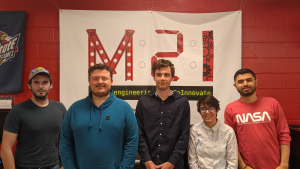Project Spotlight–RECO
We have all tried making two things stick together when we know they aren’t supposed to. It could range from pushing magnets together, gluing objects that have broken, or hoping that a handle stays on the door for the final time of fixing it. While these tasks may seem demanding, the Make to Innovate group, RECO, deals with something much more challenging.
Mehmet Safer, manager and leader of the RECO group in Iowa, discussed goals of their project. RECO is focused on finding the shear strength of metals; to do this, they are bonding two metals together through a machine and other equipment. The test involves waiting to see the amount of time the metals stay bonded—the longer the time, the better. This can range anywhere from a couple days to a couple months. The measurement used to look at this is done in hopes of getting 155 or 165 MPA. There is a scale that ranges from one to nine that is used to develop and understand this testing as well. Each number represents something different towards the metals.
“We are basically looking at the shear strength of these metals. There are different metals as well, but some can be expensive to use,” Safer said.
The metals currently being tested are both golds, so it is focusing on the gold versus gold. These are the nicer and better metals to use when testing, although they don’t last as long as others. This becomes the ultimate test of “sticking” two things together
While this testing is done in-person, the unique part of this project is that it is worked on throughout the United States, including Arizona and Connecticut. There are students from these states and others who collaborate via technology. Since they are used to being remote most of the time anyway, COVID didn’t have a huge impact on their work or progress.
Safer described the relationship RECO has working with these students. However, RECO also gets the opportunity to work with NASA; there are two experts from NASA who work directly with this project and are a huge help in conducting research. They also provide a big outlet for funding.
Most of the funding comes from NASA and the tools or other materials are provided by the own department. Iowa State is not the primary responsibility for providing these to any of the projects.
While funding is important when using specific materials, NASA provides a great opportunity that Safer talked about. NASA Technology Transfer Program is available to students, specifically those studying Aerospace Engineering, to allow their work to be reviewed. If someone makes new technology relevant to what NASA could use, they have the chance to send it in through their system and receive feedback either way. This is a great opportunity for students to learn and develop more knowledge on real-life skills.
RECO can help develop these real-life skills as well. This is the chance to work with professionals, learn about this process, and prepare for careers following school. There are ways to get involved, but Safer suggested that most students join at the beginning of the year to ease better into the project. It is also different from joining other projects since nine members are ranging around the country. By working with other colleges, this allows more viewpoints and skills to be brought in when most of the other projects don’t get that.
A huge piece with RECO includes a non-disclosure agreement. Any new member or anyone involved with this project has to sign this due to certain materials or processes being used. While Safer was able to give a great deal of information and explain the goals of this project, many things had to be closed off.
RECO is one of the great things about Make to Innovate and the projects they have to offer.
“RECO provides a lot of opportunities and NASA being involved is just one of them,” Safer said.

